Why Small Businesses Must Embrace Free Tools
In today’s fast-paced digital world, small businesses need to stay lean, agile, and resourceful. With limited budgets and big goals, tapping into free tools is not just smart—it’s essential. These tools can help boost marketing, streamline operations, and build a stronger online presence without the financial strain.
Whether you’re a solo entrepreneur or a small team, leveraging the right platforms can give you a major competitive edge. Let’s dive into the Top 5 Free Tools Every Small Business Needs to Grow Online and how you can use them effectively.
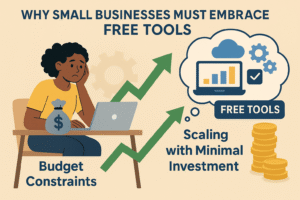
Tool 1 – Canva (Graphic Design for Everyone)
Creating visually stunning content used to mean hiring a graphic designer or wrestling with complicated software. Canva changes all that.
Why Canva Rocks:
-
- User-friendly Interface: Anyone can design flyers, social media posts, and presentations with zero design experience.
-
- Tons of Templates: Thousands of free, customizable templates for all kinds of content.
-
- Collaboration: Invite team members to edit designs in real-time.
-
- Brand Kit: Upload logos, set brand fonts and colors—even in the free version!
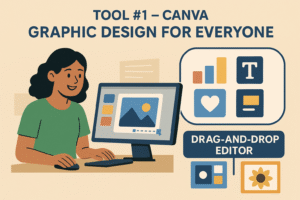
- Brand Kit: Upload logos, set brand fonts and colors—even in the free version!
Canva is perfect for:
-
- Social media marketing
-
- Website graphics
-
- Promotional materials
-
- Infographics and eBooks
Pro Tip: Use Canva’s content planner to schedule posts directly to your social media platforms.
Tool 2 – Mailchimp (Email Marketing Made Easy)
Building an email list is one of the best ways to keep in touch with your customers. Mailchimp makes email marketing accessible even if you’re just starting out.
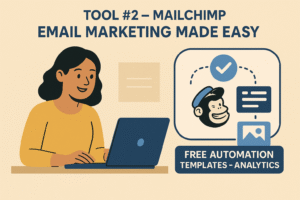
What Makes Mailchimp a Must-Have:
-
- Free Plan: Up to 500 contacts and 3,500 emails per month.
-
- Pre-designed Templates: Easy to customize with your brand.
-
- Analytics & Reports: Track open rates, click-throughs, and more.
-
- Automation: Set up welcome emails, abandoned cart messages, and newsletters with ease.
Email marketing remains one of the highest ROI channels—don’t skip this step in your business growth journey.
Tool 3 – Google Analytics (Track Your Website Like a Pro)
Your website is your digital storefront. But how do you know what’s working and what’s not? Google Analytics offers deep insights—for free.
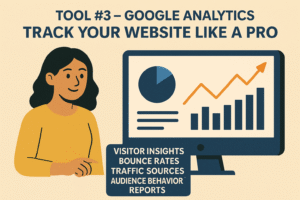
Key Features of Google Analytics:
-
- User Behavior: Learn where your visitors come from and what they do on your site.
-
- Traffic Sources: Find out whether people come from Google search, social media, or email campaigns.
-
- Bounce Rates & Conversions: See how long people stay and whether they take desired actions.
With this data, you can make smart decisions about content, design, and user experience. Set goals and watch your online presence grow.
Tool 4 – Trello (Organize Your Projects & Tasks)
Every growing business needs a way to manage projects, deadlines, and to-dos. Trello is a visual project management tool that’s both simple and powerful.
Top Uses for Trello:
-
- Task Boards: Organize projects using “boards” and “cards” for each task.
-
- Team Collaboration: Assign tasks, set deadlines, and leave notes.
-
- Custom Workflows: Tailor the process for marketing campaigns, customer onboarding, or product launches.
Even solo entrepreneurs benefit from a structured system. Trello keeps you on track, focused, and organized.
Tool 5 – Buffer (Simple Social Media Scheduling)
Consistent posting on social media is key to visibility, but doing it manually can eat up your time. Buffer simplifies it.
Why Buffer is a Time-Saver:
-
- Post Scheduling: Plan and queue content for Instagram, Facebook, Twitter, LinkedIn, and more.
-
- Analytics: See how your posts perform over time.
-
- Multi-Platform Support: Manage all your accounts in one place.
Set your week’s posts on Monday and let Buffer handle the rest. Focus your energy on engaging with your audience instead.
How These Tools Work Together for Growth
Here’s how combining these tools creates a powerful, free growth engine:
| Tool | Role in Business Growth |
|---|---|
| Canva | Enhances branding and visual appeal |
| Mailchimp | Builds relationships via email |
| Google Analytics | Tracks performance and improves strategy |
| Trello | Keeps business operations organized |
| Buffer | Maintains a consistent online presence |
Use them in tandem, and your business starts running like a well-oiled machine.
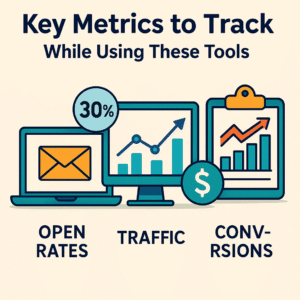
Honorable Mentions – Other Free Tools Worth Trying
-
- HubSpot CRM: Free customer relationship management platform.
-
- Grammarly: Polish your writing for emails, blogs, and website copy.
-
- Google Workspace (Basic): Docs, Sheets, and Drive collaboration for teams.
Pros and Cons of Using Free Tools
Pros:
-
- Zero cost to get started
-
- Quick setup and scalability
-
- Ideal for testing and experimenting
Cons:
-
- Limited features compared to paid versions
-
- Branding or ads may appear
-
- May lack customer support
Choose tools wisely and consider upgrading as your business scales.
Case Study: A Local Boutique’s Online Growth Using These Tools
Business: “Luna Boutique” – A small fashion shop in Austin, Texas.
Challenge: The boutique had a limited online presence and struggled with digital marketing due to budget constraints.
How They Used the Top 5 Free Tools:
-
- Canva: Created stunning social media graphics and weekly promo flyers.
-
- Mailchimp: Collected 300+ email subscribers in 3 months and increased repeat visits through automated emails.
-
- Google Analytics: Tracked which blog posts and products received the most visits and optimized content accordingly.
-
- Trello: Managed new product launches and seasonal campaigns with their 3-person team.
-
- Buffer: Scheduled Instagram and Facebook posts weekly, boosting engagement by 40%.
Results After 90 Days:
-
- 60% increase in web traffic
-
- 120% growth in email subscribers
-
- 45% boost in social media engagement
-
- 25% rise in online sales
This shows how a small team, equipped with the right free tools, can make a big impact online.
Key Metrics to Track While Using These Tools
| Tool | Metrics to Track |
|---|---|
| Mailchimp | Open rates, click-through rates, unsubscribe rate |
| Google Analytics | Traffic sources, bounce rate, session duration |
| Buffer | Post reach, likes, shares, comments |
| Trello | Task completion rates, deadlines met |
| Canva | Engagement from designed posts, ad performance (when used in campaigns) |
Tracking these KPIs helps you measure effectiveness and refine your strategy.

Top Mistakes to Avoid When Relying on Free Tools
-
- Overloading on Too Many Tools: Stick to a lean stack. Too many apps can overwhelm and reduce productivity.
-
- Ignoring Updates & Features: Free tools often update with better features. Stay informed to get the most out of them.
-
- Not Setting Goals: Every tool needs a purpose. Define what success looks like before implementation.
-
- Underestimating the Power of Integration: Many tools can be connected to automate workflows—don’t ignore that synergy.
-
- Avoiding Paid Upgrades Forever: Once your business grows, some premium features are worth the investment.
Avoiding these mistakes can maximize your results while minimizing friction.
FAQs About Free Business Tools
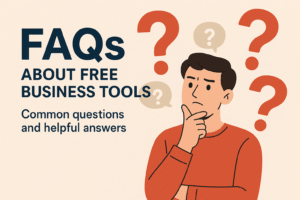
Q1: Are these tools really free, or do I need to pay eventually?
A: All tools listed offer robust free versions. However, as your business grows, premium features may become worth the investment.
Q2: Can I use these tools even if I’m not tech-savvy?
A: Absolutely! These tools are designed for beginners. Most include tutorials and intuitive dashboards.
Q3: How do I choose which tool to start with?
A: Identify your biggest challenge (design, email, analytics) and start with the tool that addresses that area.
Q4: Will these tools work on mobile devices?
A: Yes. Most of them have apps or mobile-optimized versions for on-the-go access.
Q5: What if I already have a website—do I still need these tools?
A: Yes. These tools complement your website by helping you market, measure, and manage more effectively.
Q6: Do I need all five tools right away?
A: Not necessarily. Start with 2-3 based on your immediate needs and expand as your business evolves.
Final Thoughts on the Top 5 Free Tools Every Small Business Needs to Grow Online
The digital world offers amazing opportunities for small businesses—but only if you know where to look. The Top 5 Free Tools Every Small Business Needs to Grow Online are your launchpad. With Canva, Mailchimp, Google Analytics, Trello, and Buffer, you can craft a professional presence, build customer relationships, track your performance, and save tons of time.
And the best part? You don’t need a big budget to get started—just a big vision and consistent effort.
At YourDigiHelp, we’re passionate about equipping small businesses with the tools and guidance they need to thrive in the digital space. Take action today, start small, stay focused, and let these tools—along with expert insights from YourDigiHelp—help you grow smarter, faster, and stronger online.
